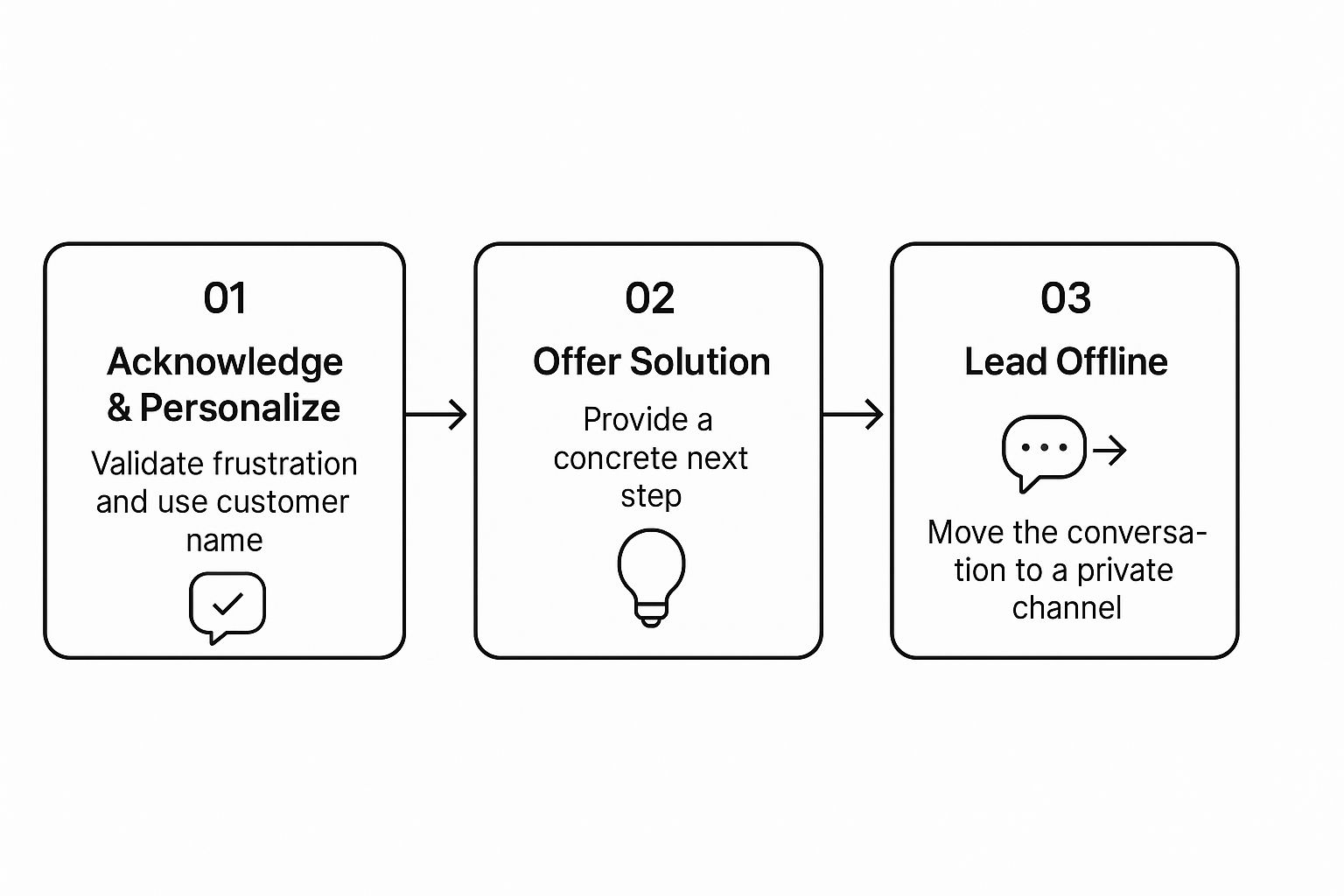When a negative Google review pops up, the right response follows a simple but powerful script: Acknowledge their frustration quickly, offer a real apology, mention their specific issue so they know you actually read it, and then offer to take the conversation offline to fix it. This isn't just about putting out a fire; it's a public display of your commitment to getting things right.
Why Responding to Negative Reviews Is Not Optional

Leaving a bad review unanswered is like telling every potential customer, "We don't really care." In a world where everyone is watching, that silence can be deafening, slowly chipping away at the trust you've worked so hard to build.
It's better to see review management not as a chore, but as a golden opportunity. A well-crafted reply can completely turn around a bad experience, highlight your fantastic customer service, and even convince a skeptical new customer to give you a shot.
The Real Impact of Unanswered Criticism
When someone looks you up on Google, they don't just glance at the star rating. They dive into the details, reading what others have said and, more importantly, seeing how you react when things go wrong. An ignored complaint sends a clear signal: you don't value customer feedback.
This isn't just a matter of perception; it hits your bottom line. Today's consumers are savvy, with a striking 73% saying they only pay attention to reviews written in the last month.
Even a business with a great overall rating can be sunk by a few recent, unanswered complaints. Research shows just four negative search results can scare away 70% of potential customers. But here’s the good news: a professional response can change everything. A solid 44.6% of customers are more likely to visit a business that actually replies to negative reviews.
Key Takeaway: Remember, your response isn't just for the person who wrote the review. It's a performance for every single future customer who is deciding whether to trust you with their money. A calm, helpful reply can be more powerful than a dozen 5-star ratings.
Let's look at the direct consequences of your actions (or inaction).
The Impact of Responding vs Ignoring Negative Reviews
| Metric | Outcome When Responding | Outcome When Ignoring |
|---|---|---|
| Customer Trust | Increases trust by showing accountability. | Erodes trust and suggests indifference. |
| Brand Perception | Seen as professional, caring, and proactive. | Perceived as unprofessional or uncaring. |
| Customer Recovery | Opportunity to win back the unhappy customer. | Almost guarantees the customer is lost for good. |
| Potential Customers | Attracts new customers impressed by your service. | Deters potential customers who see unresolved issues. |
| Local SEO | Signals positive activity to Google's algorithm. | Missed opportunity for positive engagement signals. |
As the table shows, the choice is clear. Engaging with feedback is a direct investment in your brand's health and reputation.
How Responses Influence Local SEO
Believe it or not, how you handle reviews sends signals to Google's algorithm, too. When you consistently engage with customers—the good, the bad, and the ugly—it shows that your business is active and values its community. This is a known factor in boosting your local search ranking.
Here’s how it helps:
- Signals Activity: Frequent, fresh responses tell Google your business profile is alive and well.
- Builds Trust: Publicly resolving issues is a massive trust signal, and search engines pay attention to that.
- Drives More Reviews: When people see you’re listening, they’re more inclined to leave feedback themselves, creating a positive loop.
Mastering how to respond to negative Google reviews is an essential part of any solid digital local marketing strategy. It’s about turning a potential crisis into a chance to prove just how much you care.
A Simple Framework for Responding to Tough Reviews
That sinking feeling when a one-star review pops up? We’ve all been there. It’s tempting to get defensive or just ignore it, but a solid plan removes the emotion and guesswork. Instead of fumbling for the right words, I’ve found a simple mental checklist that works every time: Acknowledge, Personalize, Offer a Solution, and Take it Offline.
This isn't some rigid script to copy and paste. Think of it more as a reliable guide. It helps make sure your reply shows both the unhappy customer—and every potential customer reading it—that you’re professional and that you genuinely care.
First, Acknowledge Their Experience and Personalize Your Reply
This first step is crucial because it sets the entire tone. "Acknowledging" the review isn't just about repeating the problem back to them. It's about validating their frustration or disappointment.
Try starting with something empathetic, like, "We're so sorry your experience didn't live up to what you expected," or "I can definitely see why you'd be frustrated by that." This instantly cools things down and shows you're actually listening.
Next, you absolutely have to personalize the response. A generic "Dear Customer" is a dead giveaway of a canned, indifferent process. If the reviewer provides a name, use it. And be sure to mention a specific detail from their comment—whether it’s the "cold coffee" or a "delayed shipment"—to prove a real human being read and understood their specific complaint.
This simple infographic really nails the core components of a winning response.

As you can see, a great response always begins with empathy before you even think about offering a fix.
Then, Offer a Real Solution
An apology without any action feels empty. Once you've acknowledged the issue, your next job is to propose a clear, tangible solution. This is where you prove you’re committed to making it right.
The solution doesn't always have to be a full refund. Depending on what happened, it could be:
- An invitation to come back: "We'd love for you to give us another try so we can show you the five-star service we're known for."
- A commitment to improve: "We've already discussed this with our team to make sure it doesn't happen again."
- A direct offer to fix it: "We would be happy to send you a replacement product right away."
My Two Cents: Stay away from vague promises like "we'll look into it." Instead, give them a concrete next step that shows you're taking ownership of the problem. This builds a ton of confidence and shows you’re accountable.
Finally, Guide the Conversation Offline
Your first response should be public, but the nitty-gritty of resolving the problem should happen in private. You really don't want a long, drawn-out debate for the world to see, and you certainly shouldn't be asking for personal customer info in a public forum.
This last step protects both your business and the customer's privacy. Simply end your public reply by inviting them to continue the conversation through a private channel.
Be specific. Don't just say "contact us." Try something like this:
- "Please email our manager, Jessica, directly at [email address] so she can personally sort this out for you."
- "Could you give our support team a call at [phone number] and mention your review? We want to get this resolved."
This approach shows you have a dedicated process for handling issues and gives the customer a clear path forward. Learning to communicate your brand's commitment is a huge part of effective content marketing for small business, because every public interaction tells a piece of your story. This framework helps make sure that story is one of professionalism and genuine care.
Why Your Response Time Matters More Than You Think

When it comes to online reviews, a great response is only half the story. The other, arguably more critical half, is speed.
A bad review left sitting there unanswered sends a loud, clear message to every potential customer who stumbles upon it. It silently screams that you're either oblivious to customer issues or, even worse, you just don't care.
A fast reply completely flips that script. It shows you're paying attention, that you're engaged, and that you're committed to getting things right. Acting quickly can change the entire narrative before the damage from the initial review even has time to set in. Think of it as your "golden hour"—a critical window to prove you’re on top of your game.
The 24-Hour Rule and What It Means for Your Business
Let's be honest, customer expectations are high. One study found that while 63% of people expect a business to reply within three days, a shocking 75% of businesses don't bother responding to negative reviews at all.
That massive gap is your opportunity. Simply showing up and replying quickly gives you an immediate competitive advantage. It's one of the easiest ways to stand out from the crowd.
Even better, 70% of customers report being more likely to leave a review if they see a business actively responding to others. Your quick, consistent engagement actually encourages more feedback, building a more transparent and trustworthy reputation over time. You can learn more about why Google reviews are essential in 2025 and see how your activity fits into the bigger picture.
Remember, your response isn't just for the person who wrote the review. It’s a public performance for every single future customer. A swift, professional reply shows you’re a business that listens and takes action—building trust before they even contact you.
How to Set Up a System for Rapid Responses
Hoping you'll just happen to see new reviews is not a strategy. To really master how to respond to negative Google reviews, you need a reliable system that ensures nothing falls through the cracks. The goal is to make prompt replies a natural part of your daily workflow.
Here’s how to build a simple but effective process:
- Turn on Instant Notifications: This is non-negotiable. Head into your Google Business Profile settings and make sure email notifications are enabled for all new reviews. This is your first line of defense.
- Assign Clear Ownership: Decide who is responsible. Whether it's one person or a small team, make it crystal clear who owns the task of monitoring and responding. If everyone thinks someone else is handling it, no one will.
- Use Response Snippets (But Be Smart About It): Don't use canned, robotic templates. Instead, create a document with pre-approved phrases for common situations—think greetings, apologies, or closing remarks. This saves time on the repetitive parts so you can focus on personalizing the most important details of the response.
Putting these simple steps in place guarantees that no review—good or bad—sits unanswered for more than 24 hours. This kind of consistency not only keeps customers happy but also signals to Google that you're an active, engaged business, which can give your local search visibility a nice boost.
How to Handle Tricky Reviews: The Good, The Vague, and The Fake
Let's be real: not all negative reviews are the same. A genuinely unhappy customer with a detailed complaint requires a different touch than a one-star review with no text or a flat-out fake attack from a competitor. To master your response strategy, you need to know how to read the situation and react accordingly.
Most of the feedback you get will be legitimate. For those, a simple framework works wonders: Acknowledge their issue, Personalize your reply, Offer a solution, and Take the conversation offline. It’s a classic for a reason—it shows you’re listening and ready to make things right.
But what about the weird ones? Your response isn't just for the original poster; it’s a performance for every potential customer who reads it. This isn't just a hunch. A recent study found that 56% of consumers said a business's response to feedback changed their perspective on that company. As you can see from these insights on responsiveness from Taggbox.com, how you engage matters. A lot.
Dealing with Vague One-Star Reviews
You know the ones I'm talking about. The one-star rating with zero explanation, or maybe a single word like "Bad." They’re incredibly frustrating because you have nothing to work with. The temptation is to get defensive or just ignore it, but that’s the worst thing you can do.
Your real goal here is to publicly show that you’re open to a conversation and want to understand what went wrong. A calm, professional, and genuinely curious response is your best move.
Here’s a simple, effective way to handle it:
"Hi [Customer Name], we’re sorry to see you had a one-star experience with us. We're always looking for ways to improve and would appreciate it if you could share more details about what happened. Please feel free to contact our manager, David, at [email address] so we can learn more."
This little paragraph does three big things:
- It acknowledges their rating without blindly accepting an unstated problem.
- It shows everyone else that you care about feedback and want to improve.
- It moves the conversation to a private channel where you can have a real discussion.
Spotting and Flagging Fake Reviews
Sometimes, a review just feels… off. The name doesn't show up in your customer database, they describe a service you don’t even offer, or the details are just plain wrong. This could be a malicious competitor, a bitter ex-employee, or even just someone who confused your business with another.
Your first instinct might be to fire back, but don't. Your first move should always be to report the review to Google.
Gather any proof you have that the review is bogus—no record of the customer, an inaccurate description of events, etc.—and flag it directly within your Google Business Profile. Google's policies are clear about prohibiting spam, off-topic content, and conflicts of interest. While you wait for Google to review your request (which can take a few days), it's smart to post a calm, measured public response.
Try something like this:
"Hello, thank you for taking the time to leave feedback. We take all customer experiences seriously, but after a thorough check of our records, we're unable to find any client information matching your name or the details described in your review. We would appreciate the opportunity to look into this further if you could contact our office at [phone number]."
This response is perfect because it's professional and avoids making accusations. It lets other readers know that you've done your due diligence and can't verify the claim. This gently undermines the review's credibility without sparking a public fight, protecting your reputation while Google does its thing.
Turn Customer Feedback Into Your Greatest Asset

The real gold in a negative review isn't just managing your public image—it's the free, unfiltered business intelligence it hands you. Every piece of feedback, no matter how tough it is to read, offers a direct look into your customer's experience. This is your chance to shift from reactive damage control to proactive business improvement.
Think of your reviews as a raw dataset just waiting for you to connect the dots. Instead of viewing each one as a one-off fire to put out, start looking for the patterns. You don't need fancy software to get started; a simple spreadsheet or even a notes app is enough to begin logging the core issues people are pointing out.
Suddenly, those abstract complaints become concrete, actionable insights that help you answer some really important questions about your business.
Identifying Actionable Themes
Are you noticing that different customers keep bringing up the same issue? That's not a coincidence. It's a massive red flag signaling that something in your process is broken and needs attention.
I've seen the same themes pop up time and time again. Keep an eye out for these:
- Process Bottlenecks: Do people consistently mention slow service, long wait times, or a checkout process that’s more confusing than it should be?
- Product or Service Gaps: Are there recurring complaints about a specific dish on your menu, a product that keeps failing, or a service that just doesn't deliver on its promise?
- Staff Performance: Is a particular employee's name—or even a specific role, like "the weekend manager"—coming up repeatedly, for better or for worse?
Once you start gathering this data, you have a clear mandate for change. If "slow shipping" is a constant refrain, it's time to take a hard look at your fulfillment partners or internal logistics. If one team member is getting endless praise, you can use their approach as the new gold standard for training everyone else. For businesses looking to streamline this process, understanding tools for managing customer feedback from maps reviews can be a game-changer.
Key Insight: Don't just respond to the review; respond to the underlying problem within your business. Fixing the root cause is the most powerful way to show you’re listening, and it stops the same negative review from happening again.
This is what it means to close the feedback loop. By turning criticism into tangible operational improvements, you don't just solve one person's problem—you make the experience better for every single customer who comes after them. Using feedback strategically is a surefire way to increase customer lifetime value and build a much stronger, more customer-centric business.
Navigating the Tricky Situations: Your Review Response FAQs
Even with a solid game plan, you're bound to run into some weird and tricky situations. Knowing how to handle the nuances of certain negative reviews is what separates the pros from the amateurs. Let's walk through a few of the most common curveballs I see business owners face.
A big one I get asked about all the time is whether you should offer a discount or a freebie in your public response. It feels like an easy win, a quick way to smooth things over. But be careful—this can backfire.
When you offer compensation publicly, you're setting a precedent. Suddenly, you might find more people complaining, hoping for their own handout. It can create a culture where a negative review becomes a transaction.
Here's my two cents: Always, always offer to make it right. But keep the specifics of that offer—the refund, the free dessert, the discount—in a private conversation. Your public reply should be about the apology and the invitation to connect offline. This shows you're committed to a solution without inviting everyone to the party.
What Do I Do if a Review Calls Out an Employee by Name?
This is easily one of the most delicate spots you can be in. You have a responsibility to your customer, but you also have a responsibility to your team. The absolute key is to handle it publicly without throwing your employee under the bus.
Your response needs to be professional and, frankly, a little vague about what happens next internally. Acknowledge the customer's feedback and reassure them that you take service quality seriously.
Here's what that looks like in practice:
- Don't: Publicly shame your employee or talk about disciplinary action. That's a one-way ticket to a team morale disaster and potential legal headaches.
- Do: State that you'll be looking into it with the team. This shows you're taking action without airing your dirty laundry.
For instance, you could say something like: "Thank you for bringing this to our attention. We take feedback about our team members very seriously and will be addressing this internally to ensure we're always providing the excellent service we aim for." It validates the customer's concern without turning it into a public spectacle.
Should I Bother Responding to a Review That’s an Obvious Mistake?
Yes. Absolutely. You'll occasionally get a review that's clearly meant for another business. Maybe they're complaining about the terrible pizza at your accounting firm. Even though it has nothing to do with you, that one-star review still hurts your overall rating.
Ignoring it isn't an option. A simple, polite correction is all you need.
Try this: "Hi [Reviewer Name], thank you for taking the time to leave a review. I think there might be a bit of a mix-up, as we're a marketing agency and don't actually serve pizza! We believe you may have intended to leave this for another business, but we wish you the best."
This little bit of effort clears up any confusion for people scrolling by and gently prompts the reviewer to fix their mistake. More importantly, it shows you're paying attention to every detail of your online presence.
At Sugar Pixels, we know that a killer online presence is about more than a great-looking website—it’s about managing your reputation with skill and professionalism. Let us handle the digital heavy lifting so you can get back to what you do best. Build and scale your online presence with us.